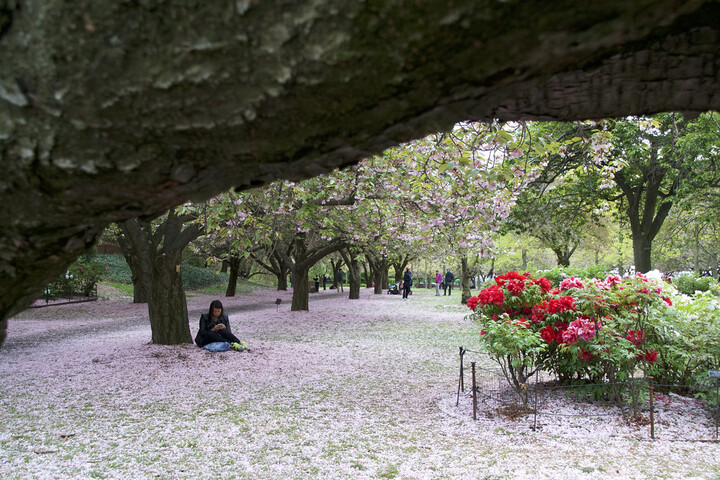Thousands of visitors have been flocking to Brooklyn Botanic Garden this spring, and every spring, to view our collection of flowering cherries. They may be the most beloved trees in New York City. Still, there are many things most people don’t realize about these beautiful pink- and white-blossomed plants. Here are some little-known facts.
They make fruit.
Well, many of them do, anyway. Though these trees were bred for flowers, not fruit, some do produce small cherries, which appear during the summer. They’re too sour for people to eat, but birds like them.
Any given tree may only be in full bloom for about a week.
Cherry blossom season usually lasts about a month from the earliest bloomers—this year the ever-blooming cherry (Prunus sargentii 'Fudan-zakura')—to the latest, usually the 'Kanzan' (P. ‘Kanzan’) and the 'Ukon' (P. serrulata ‘Ukon’). But an individual tree may only be in bloom for a week or two, depending on the weather. Of course, if they were in bloom all the time, they wouldn’t be so special.

Which cherries are blossoming right now? Visit the CherryWatch Blossom Status Map to find out.
They don’t live long.
Like their blossoms, flowering cherry trees themselves are fairly ephemeral too, at least as trees go. Most cultivars live only 30 to 40 years. Brooklyn Botanic Garden's collection includes some of the oldest specimens in North America, though—the two weeping higan cherries (Prunus subhirtella 'Pendula') at the north end of Cherry Walk. Those were part of the original 1921 planting.
Flowering cherries actually don’t belong in a traditional Japanese garden.
Conifers, maples, azaleas, and mosses are all much more common in traditional Japanese gardens, which are created to showcase year-round seasonal interest. In Japan, flowering cherries, with their short blooming period, symbolize the ephemeral. They’re more likely to be planted in parks, where Hanami is pretty much celebrated as a drunken picnic. Office workers make their interns go out early in the morning with a blanket to stake out a spot under the cherry trees—kind of like movie nights in Bryant Park. Then later everyone shows up with the food and sake. Still, compared with cherry festivals in the U.S., they are rather solemn events where everyone contemplates the impermanence of life.
Here in Brooklyn, it would be hard to have a Japanese garden without including a plant so closely associated with Japanese culture. That’s why BBG horticulturists have always included flowering cherries in the Japanese Hill-and-Pond Garden.
The blossoms change colors.
Many are dark pink when in bud, lighter pink when they first blossom, and then eventually pale pink or white. There are some interesting variations on this, though. The blossoms of ‘Ukon’, for instance, progress from greenish yellow to white, and then pink.
The trees on Cherry Esplanade have five times the typical number of petals per flower.
Cherry blossom species naturally have five petals, but some cultivars are bred for fuller blossoms and have many more. The pink double blossoms of ‘Kanzan’ have as many as 28 petals each. Interestingly, in Japan, many people would consider this rather gaudy. There, the most popular cherry blossom is the Yoshino (Prunus x yedoensis), which has five white petals and is treasured for its delicate, simple form.

Take virtual strolls to savor cherry trees at peak bloom in the Japanese Hill-and-Pond Garden and on Cherry Esplanade.
The flowering cherries on sale at home improvement stories are Franken-trees.
You see these around a lot—they look like mops or umbrellas or octopus trees. They are probably weeping higan branches grafted onto to a cherry with a straight trunk that was cut off at five feet tall. I don’t blame people for buying them because they’re one of the only widely available options. It’s a shame, though, because they are often really weak and unhealthy. If you look around a little, you can probably find upright higan or Yoshino cultivars for sale, which I think are much nicer options.
This year aside, they are blooming earlier every year.
Lots of people think this year’s cherry blossoms are “late” since the trees flowered so much later than they did last year. But this year’s bloom times are actually pretty close to what used to be normal. The overall trend is for them to blossom a little earlier each year. That’s due to climate change. It wasn’t that long ago that Sakura Matsuri was scheduled for the first weekend in May, which corresponded pretty well with Cherry Esplanade's being in bloom. Now, more often then not, it’s sometime in April.
Take virtual strolls to savor cherry trees at peak bloom in the Japanese Hill-and-Pond Garden and on Cherry Esplanade.
The flowering cherries on sale at home improvement stories are Franken-trees.
You see these around a lot—they look like mops or umbrellas or octopus trees. They are probably weeping higan branches grafted onto to a cherry with a straight trunk that was cut off at five feet tall. I don’t blame people for buying them because they’re one of the only widely available options. It’s a shame, though, because they are often really weak and unhealthy. If you look around a little, you can probably find upright higan or Yoshino cultivars for sale, which I think are much nicer options.
This year aside, they are blooming earlier every year.
Lots of people think this year’s cherry blossoms are “late” since the trees flowered so much later than they did last year. But this year’s bloom times are actually pretty close to what used to be normal. The overall trend is for them to blossom a little earlier each year. That’s due to climate change. It wasn’t that long ago that Sakura Matsuri was scheduled for the first weekend in May, which corresponded pretty well with Cherry Esplanade's being in bloom. Now, more often then not, it’s sometime in April.